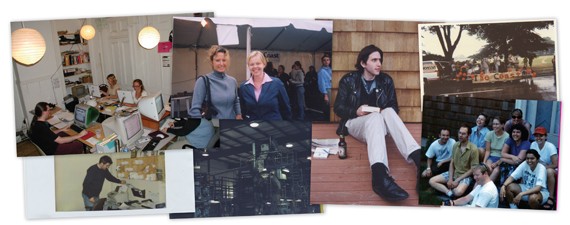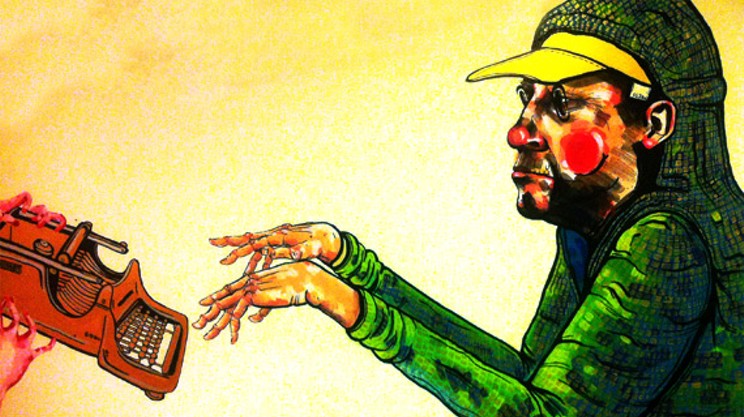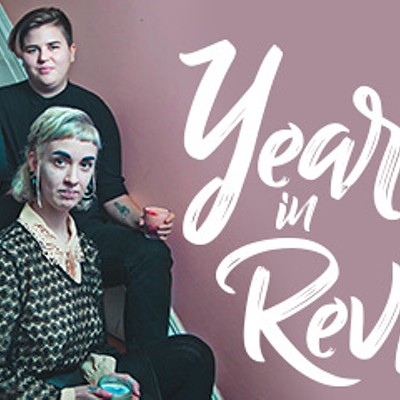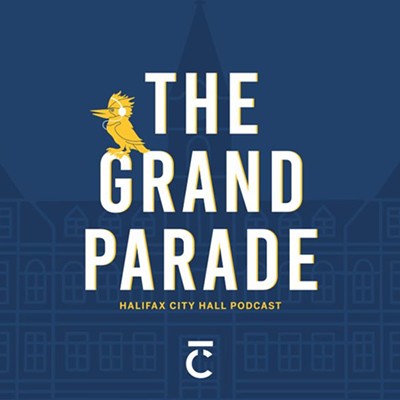
This newspaper you hold in your hands...the one whose weekly listings have long since become required reading for anyone in Halifax going anywhere at anytime to do anything; whose annual Best of Halifax plaques are sought-after cultural seals-of-approval for local businesses from restaurants to clothing boutiques to neighbourhood barber shops; whose commercial success has spawned its own stable of six standalone city guides on everything from pets to living green, not to forget a twice-yearly Halifax wedding planning guide; and whose take-no-prisoners journalism led to the erection of a suicide prevention fence on the Angus L. Macdonald bridge and sent a sitting mayor to the electoral sidelines? That's right...the same little Halifax alt-weekly that's playing with journalism's big boys next month for a prestigious national Michener prize for "meritorious public service," the one celebrating its 20th anniversary with the issue you're holding in your hands.
You can thank me for that. All of it. It was my idea. No, really...
OK, so here's the official story. It was circa the October-ish fall of 1992. I was sitting in my office in the Journalism School at the University of King's College. I had visitors: Kyle Shaw, who'd already graduated from our one-year journalism program but couldn't bring himself to leave so had hung around campus for another year as president of the students' union, and Andy Pedersen, his good friend and soon-to-be underemployed journalism grad. They were seeking my sage advice, trying to sort out what to do with the rest of their lives or, failing that, what they could do and get paid for that summer.
It so happened I had a brilliant idea. I'd spent a sabbatical three years earlier at the Halifax Daily News helping launch an entertainment weekly called SEVEN DAYS. But I'd just learned from friends at the paper the powers-that-were had decided to kill it off... something about a lack of advertising sales.
"Look," I said sagely. "There's going to be this opening in the market. Why don't you guys start your own arts and entertainment paper?"
That was the start. Everything else (see above) flowed from that moment.
OK, OK, back that truck up a block.
That's their story, and I'm sticking with it. But I don't remember suggesting they start a publication. I don't know why I would have. From early 1987 to late 1989, I'd been the editor, publisher, co-owner and occasional delivery boy for my own Halifax publication, a glossy, faux Toronto Life monthly called Cities. It went bust at the height of its success for that most commonplace of reasons: lack of capital. Publishing it had been an exhilarating, all-consuming, relationship-testing, soul-destroying, money-sucking two-and-a-half-year rollercoaster ride I wouldn't have wished on my worst enemies, let alone two eager journalism grads I considered friends.
I told them to forget it.
They heard "go for it."
So they did.
In the beginning, there were six of them: Kyle and Andy, Christine Oreskovich, Andy Lamey, Aran Rasmussen and Tom Lissaman.1 Christine was a second-year King's student, the others would graduate that spring.
By the time they left for Christmas break, they even had a name for their new venture: Red. "You know," explains Kyle today, "a homophone with 'read,' a bright visual sort of word, as well as an attempt to reclaim the word from its communist associations." By the time they returned a few weeks later, they'd had a collective change of heart. At their first meeting in January 1993, Kyle says "all six of us bring up this fact that we need to change the name." Journalist Wilf Dinnick, later the founder of OpenFile, eventually suggested the name The Coast.
Pooling their meagre-to-no resources, they rented a dingy office-cum-crash pad that spring in the don't-go-there basement of a decaying downtown building under what is now Chives restaurant, a claustrophobic space made even less habitable because, as Kyle admits, "we were working like crazy and no one wanted to clean up." Initially using Mac computers "borrowed" from the journalism school, they set about creating the look and feel of The Coast, and crafted a mission statement that still appears every week in the paper's masthead: "to be provocative, entertaining and truthful."
By today's Coast standards, that first issue—16 pages, 10,000 copies of an every-two-week publication—was nothing to write home about. But it was ink-on-paper real... and something much more significant.
With a cover featuring a then-popular all-female local indie rock band called jale and a main news story on "The Swarming Buzz: Has the city's youth really gone wild?"—now-CBC journalist Jerry West wrote that recent downtown incidents were "unacceptable," but "they hardly represent the vast migration of violence into the streets of Halifax that most reports claim they do"—that first edition established what Kyle now calls "a good tone for a publication that cares about setting the record straight on city life from arts to current affairs."
The Coast was not going to be your stodgy Chronicle-Herald, or your parents' CBC Radio. It would be a successor worthy of The 4th Estate, journalist Nick Fillmore's popular muckraking weekly that had flourished briefly in the city during the 1970s.
But hipper. And better. And more successful. Much more successful.
When I talk about The Coast with my students today, I'm surprised how often they see its existence---and its success---as a given, simply part of the contemporary urban journalism landscape.
They don't know the tenth of it.
Consider this vignette about the Coast-making process from a profile of Kyle I wrote for the old Daily News in 1995: "Go back a few days. To Tuesday. Or, more precisely, to the early hours of Wednesday morning. That's when Shaw finally left The Coast office in downtown Halifax. He was back at work at 2pm, barely seven hours later. It's now Thursday at 9pm—31 hours later—and he still hasn't slept. He won't get much chance to rest in the next 48 hours either. The Coast...is ready to be picked up at the printers. So Shaw and a few fellow Coasters will spend the next two days delivering 13,000 copies of their latest issue to virtually every bar and club and book store and record shop and retailer—not to forget corner store—from Bedford to Cole Harbour and places in between. And then they will start over again."
For the first couple of years, they didn't—couldn't—pay themselves a salary. They survived, thanks to part-time jobs or living at home. When they finally began reaping the rewards of all that sacrifice, their initial salaries were $100...a month.
But The Coast itself—an irreverently eclectic, vital urban lifestyles alt-weekly, deftly mixing an intoxicating brew of culture, entertainment and politics—thrived almost immediately.
One of the things that surprised me when I started writing occasional features for The Coast during its second decade was realizing just how many of my middle-aged and older friends—few of them of the downtown bar/nightlife persuasion—read it religiously from cover to cover every week.
The Coast was how they—and, seemingly, everyone else in Halifax—discovered their city.
There are any number of pivot points in the evolution of any successful publication.
For The Coast, there was that first-year moment when members of Sloan—the band that had helped put Halifax on the '90s entertainment map—agreed to guest edit an issue, placing a pop-culture cool imprimatur on its pages, and the issue after that when the late, lamented Sam the Record Man became a regular advertiser, giving the paper national retail-chain commercial legitimacy.
But if you asked me to name the game-changer moments in Coast history—leaving aside, for the sake of modesty, my suggestion they launch it!—I would single out two: that day in 1996 Kyle and Christine met soon-to-be-investor and now Coast president Catherine Salsibury, and their decision 11 years later to appoint dog-with-a-bone journalist Tim Bousquet news editor.
Salisbury was one of the founders of the Montreal Mirror, an English-language alt- weekly with a reputation for being "original and raw," started almost a decade before The Coast. Kyle and Christine had invited Canada's alt-weekly publishers to Halifax, for a journalism get-together to coincide with the Pop Explosion music fest, and Salisbury was the only one who accepted. The three "hit it off," Kyle remembers, and Salisbury "proposed we team up and she'd use her expertise to turbo-charge our progress."
In spite of its success with readers, The Coast was under-capitalized, exhausting its over-worked owners and careening from printing bill to printing bill. Partnering with Salisbury solidified The Coast's financial position, and gave the paper the wherewithal to switch to weekly publication, the sine qua non of any successful urban alt weekly.
Bousquet, a crusading American-born journalist, arrived in Halifax in 2004. By 2006, he was writing an environmental-issues column for the paper called "Sustainable City." Within a year after that, he was the news editor. Within another year, he was handing out public "report cards" to city councillors, including a D to mayor Peter Kelly.
It wasn't that The Coast hadn't been doing hard news before Bousquet came along. And it wasn't that Bousquet was always right; the paper has had to issue apologies for a couple of his stories. But he brought a passion and a panache to local news that quickly made him a must-read among the city's chattering classes. The concertgate scandal, council secrecy and, of course, the story of the mayor's questionable handling of a friend's estate that ultimately drove him from office, all helped establish The Coast as an important force in journalism. In Halifax. And beyond.
Coast alumni have made their marks in the larger world too. Matthieu Aikins, the young freelancer whose story about an Angus L. Macdonald bridge jumper forced the bridge commission to rethink its suicide prevention policy, is now based in Kabul, Afghanistan, reporting for magazines like Harper's and GQ. Former news editor Mike Fleury is a producer for CBC-TV's George Stroumboulopoulos Tonight. Former managing editor Stephanie Domet is a ubiquitous CBC radio host. Award-winning feature writer Lezlie Lowe is a Herald columnist and journalism prof. Former listings editor Mike Landry is arts and culture editor for the NB Telegraph-Journal. Former arts editor Sue Carter Flinn is web editor at Quill & Quire magazine. Michael de Adder used to draw cartoons for The Coast, and now does them for nearly every major media outlet in the country.
Onetime advertising sales manager Heidi Hallett went on to own Frog Hollow book store, and now runs the Writers' Federation's Writers in the Schools program. Former art director Chris Mueller creates covers for Vanity Fair. Another former art director, Devin Slater, is the design editor at the Globe and Mail. Still another, Kate O'Connor, is art director for the multinational Chiat/Day ad agency in Los Angeles. And Hannah Thomson, who used to take photos for The Coast, now snaps party pics for Vogue and Vanity Fair.
If imitation is the sincerest form of flattery, The Coast has also been well and truly flattered. While he was a student at the journalism school in 2005, a Newfoundlander named Elling Lien decided to create a Coast-like publication for St. John's (The Scope will soon celebrate its seventh anniversary). And just last week I got an email from two brothers, King's alumni, starting a newspaper, The Citizen Journal, in Honduras. "In a country where four daily newspapers manipulate public opinion, a new approach is needed," they wrote. "We were inspired by The Coast to propose citizen journalism to challenge corporate media." And so it goes.
History, of course, is no guarantee of future success. Publishing is now an even tougher business than it was 20 cutthroat years ago when The Coast began...the year, incidentally, when the first web browser was launched, changing journalism forever.
But let's not go there. Not now. Not today. Let's celebrate 20 years of being truly "provocative, entertaining and truthful."
Oh, and by the way, did I tell you it was all my idea? You're welcome.
--Coast godfather Stephen Kimber is the go-to guy for great magazine-style stories. His latest Coast cover feature was about the Mooseheads, Canada's hockey kings, in April, and his next non-fiction book, What Lies Across the Water: The Real Story of the Cuban Five, comes out in August.
1 Lamey, who left after that first summer to become an intern at The New Republic, is now a freelance journalist, radio documentary maker and author. His 2011 book, Frontier Justice: The Global Refugee Crisis and What To Do About It, is published by Random House. Andy Pedersen went on to become an editor at the Halifax Daily News, a freelance writer, TV documentary and filmmaker. He is currently a national representative for the National Union of Public and Government Employees Union based in Ottawa. Tom Lissaman, the original marketing guy, left after a year to go to law school. He’s now a prominent crown prosecutor in Toronto. Aran Rasmussen, a poli-sci grad who oversaw the design of the original Coast, moved to Chile in 1995 where he designed La Epoca, the first online edition of a daily newspaper in Chile. He’s now Senior Project Officer at PALM + HAVAS, a Montreal-based communications agency. The survivors from the original Gang of Six—Kyle, now the editor, and Christine, now the publisher—married in 2002.
















